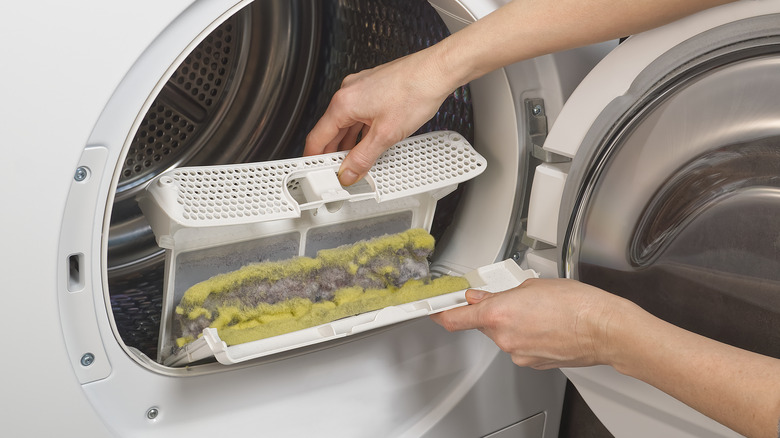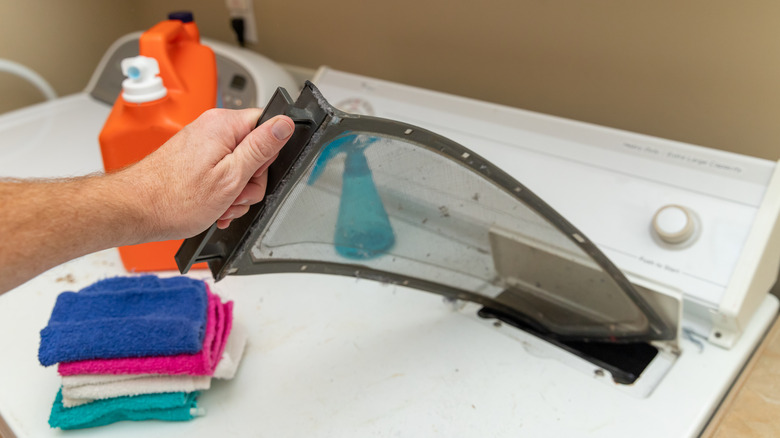The Kitchen Utensil That'll Make Cleaning Your Lint Trap A Breeze
Cleaning your dryer's lint trap is an annoying chore, but statistically it could save your life. According to the National Fire Protection Association, dryers cause more than 13,000 residential blazes each year, with 32% resulting from improper cleaning — primarily due to lint buildup. Sure you can easily give the dryer's lint screen a quick wipe, but if you want to snag the wads of hair, fiber, and debris that don't adhere to the removable trap, skip the tool shed and head to the kitchen utensil drawer. Turns out a simple pair of chopsticks can serve as affordable finger extensions to effectively pluck fuzz from the lint trap slot.
Fortunately, you don't have to possess the epic chopsticks skills of Mr. Miyagi in "The Karate Kid" to rid your dryer of lint clumps. In fact, you don't even need to own high-end chopsticks made of porcelain, ceramic, metal, or jade to execute this cleaning hack. Ironically, ordinary wooden disposable chopsticks that come with your sushi takeout are fully capable of extracting lint from the dryer's trap. Additionally, once you experience the ease and satisfaction by which the cooking/eating utensils seize excess fuzz that slips through lint trap cracks, you'll be able to execute the technique on autopilot. And you'll thank yourself for doing so as regularly keeping your dryer lint-free maximizes the appliance's efficiency, reduces energy bills, and potentially avoids major repairs.
Why and how to use chopsticks to remove lint from your dryer
Successfully cleaning lint from your dryer requires more than occasionally peeling off built-up debris from the detachable screen. Often globs of gunk escape the lint trap's mesh filter and accumulate in the cavity that houses the removable screen. When this happens many homeowners reach for a vacuum to suck up bits of stray lint. However, if you don't have the energy to haul out the entire machine or the vacuum's hose attachment simply doesn't fit into the narrow opening that houses the lint screen, it's chopstick time.
To start, remove the cleaned lint trap and peer into its open slot to see where large pieces of residue have collected. Use a flashlight if needed. After identifying the location of the lint clumps, you have multiple options. Advanced chopstick users can use one hand to maneuver both sticks to pluck and lift individual masses out of the lint trap's opening in the same manner you would a small piece of fish. Another method is to tightly grip one chopstick in each hand, uniting them only after you've pinched a lint wad in between the sticks, then lift and remove. Finally, you can firmly grip a single chopstick, insert it into the trap's gap, and use it to gently scrape and lift up stray fluff — using the side where the lint has attached itself to anchor the clumps as you slowly raise them out of the crevice.
Tips to consider
Chopsticks come in handy when cleaning a dryer's lint trap, but they're not foolproof. Internet forums are filled with distressed homeowners who have accidentally lost chopsticks while using them to clean lint trap compartments. If you lose your grip on a chopstick and it falls into the lint trap slot, you can retrieve it by wrapping the end of a straightened wire clothes hanger with double-sided tape or duct tape (sticky side out), lowering it into the compartment, sliding it side to side until the errant chopstick adheres to the tape, then slowly lift out. If you don't have a metal hanger, substitute with a long handled wooden spoon or an elongated, two-pronged grilling fork. Otherwise, a long spatula or a marshmallow roasting stick will do the trick. Just remember to securely adhere the tape to the tools, as you don't want to inadvertently lose it to the lint trap compartment abyss as well.
In addition, if you're concerned that a single chopstick is not long enough to reach the assembled fluffballs clinging to the sides of the lint trap cavity, consider taping two or three of the wooden utensils end to end to form one long rod. Finally, once you've successfully recovered a healthy-sized batch of lint from your dryer using chopsticks, consider saving it. You can repurpose lint to fill throw pillows or spread out a thick layer in your garden to prevent weeds.


